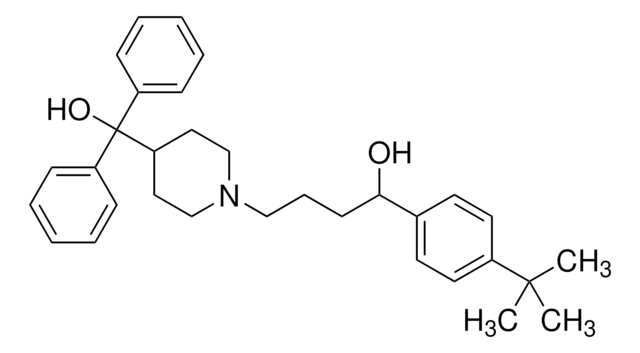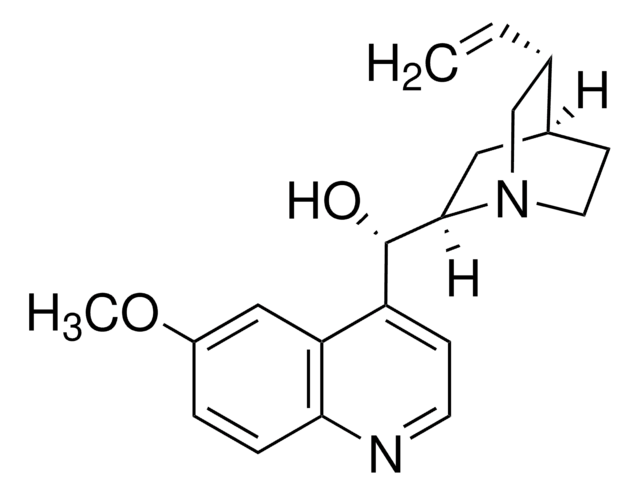A7205
3-Acetamidophenol
97%
Sinónimos:
3′-Hydroxyacetanilide
Iniciar sesiónpara Ver la Fijación de precios por contrato y de la organización
About This Item
Fórmula lineal:
CH3CONHC6H4OH
Número de CAS:
Peso molecular:
151.16
Beilstein:
907998
Número CE:
Número MDL:
Código UNSPSC:
12352100
ID de la sustancia en PubChem:
NACRES:
NA.22
Productos recomendados
Nivel de calidad
Ensayo
97%
Formulario
crystals
mp
145-148 °C (lit.)
cadena SMILES
CC(=O)Nc1cccc(O)c1
InChI
1S/C8H9NO2/c1-6(10)9-7-3-2-4-8(11)5-7/h2-5,11H,1H3,(H,9,10)
Clave InChI
QLNWXBAGRTUKKI-UHFFFAOYSA-N
¿Está buscando productos similares? Visita Guía de comparación de productos
Categorías relacionadas
Palabra de señalización
Warning
Frases de peligro
Consejos de prudencia
Clasificaciones de peligro
Eye Irrit. 2 - Skin Irrit. 2
Código de clase de almacenamiento
11 - Combustible Solids
Clase de riesgo para el agua (WGK)
WGK 2
Punto de inflamabilidad (°F)
Not applicable
Punto de inflamabilidad (°C)
Not applicable
Equipo de protección personal
dust mask type N95 (US), Eyeshields, Gloves
Elija entre una de las versiones más recientes:
¿Ya tiene este producto?
Encuentre la documentación para los productos que ha comprado recientemente en la Biblioteca de documentos.
Identification of hepatic protein targets of the reactive metabolites of the non-hepatotoxic regioisomer of acetaminophen, 3'-hydroxyacetanilide, in the mouse in vivo using two-dimensional gel electrophoresis and mass spectrometry.
Y Qiu et al.
Advances in experimental medicine and biology, 500, 663-673 (2002-01-05)
M A Bae et al.
Molecular pharmacology, 60(4), 847-856 (2001-09-20)
Acetaminophen (AAP), a widely used analgesic drug, can damage various organs when taken in large doses. In this study, we investigate whether AAP causes cell damage by altering the early signaling pathways associated with cell death and survival. AAP caused
M A Tirmenstein et al.
The Journal of biological chemistry, 264(17), 9814-9819 (1989-06-15)
Acetaminophen (250 mg/kg) administered intraperitoneally to fasted, phenobarbital-induced mice produced hepatotoxicity. No hepatotoxicity was observed after the administration of the regioisomer 3'-hydroxyacetanilide (600 mg/kg). Similar levels of covalent binding to liver homogenates occurred in mice receiving either acetaminophen or 3'-hydroxyacetanilide
N G Palmen et al.
Toxicology, 84(1-3), 157-170 (1993-11-12)
A model system for the detection of reactive metabolites, using glutathione depletion after microsomal activation, has been described previously. We developed a battery of complementary test systems using rat liver microsomes for metabolism and aqueous glutathione solutions, human erythrocytes or
T G Myers et al.
Chemical research in toxicology, 8(3), 403-413 (1995-04-01)
Acetaminophen (4'-hydroxyacetanilide), a widely used analgesic/antipyretic drug, is hepatotoxic in large doses, whereas the m-hydroxy isomer of acetaminophen, 3'-hydroxyacetanilide, is not hepatotoxic. Both are oxidized by mouse liver cytochromes P-450 to reactive metabolites that bind covalently to hepatic proteins. Because
Nuestro equipo de científicos tiene experiencia en todas las áreas de investigación: Ciencias de la vida, Ciencia de los materiales, Síntesis química, Cromatografía, Analítica y muchas otras.
Póngase en contacto con el Servicio técnico




